A. Compound Duple Meter as 6/8
Basic Exercises in 6/8
In Chapter 2A, we will explore excerpts that use a time signature of 6/8 to reflect compound duple meter. Compound-meter time signatures are most easily identified by their top number of 6, 9, or 12. The top number represents the number of beat divisions per measure. The bottom number indicates the rhythmic value assigned to the beat division. In compound meter, the beat divisions are grouped in threes, and you can determine the number of beats a compound-meter time signature indicates by dividing its top number by 3. As such, 6/8 has two beats per measure (6 divided by 3 equals 2), 9/8 has three beats per measure (9 divided by 3 equals 3), and so on. The conducting patterns for 6/8, 9/8, and 12/8 are based on the number of beats per measure; as such, you can use the same two-, three-, and four-patterns that were shown in Chapter 1.
Exercise 2A-1 has near-constant eighth notes, which enforces strong internal beat division. The remaining exercises are arranged in order of difficulty, starting with the most straight forward exercises. It is recommended that you have worked through some of Chapter 1C and are familiar with dots and ties before attempting the exercises in this chapter.
Exercise 2A-1: Nicolas Chédeville, Les Deffis, ou L’étude amusante, Op. 9, L’Holandoise

Exercise 2A-2: Nicolas Chédeville, Les Deffis, ou L’étude amusante, Op. 9, La Bevilloisse

Exercise 2A-3: Hector Berlioz, Roman Carnival Overture, H 95, Op. 9

Exercise 2A-4: Roger Quilter, Old English Popular Songs, Number 2, “Drink to Me only with Thine Eyes”

Exercise 2A-5: Heinrich Molbe, Scènes des Sylphides, Op. 66

Exercise 2A-6: Rebecca Clarke, Cradle Song

Exercise 2A-7: Juventino Rosas, Julia

Exercise 2A-8: Ludwig van Beethoven, Violin Concerto in D major, Op. 61, Movement 3

Exercise 2A-9: John Philip Sousa, The National Game

Exercise 2A-10: Cécile Chaminade, Children’s Album, Op. 123, Number 4, Rondeau


